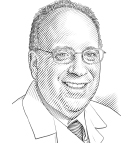Guest Editor

Stuart M. Lichtman, MD
Geriatrics for the Oncologist is guest edited by Stuart M. Lichtman, MD, and developed in collaboration with the International Society of Geriatric Oncology (SIOG). Dr. Lichtman is an Attending Physician at Memorial Sloan Kettering Cancer Center, Commack, New York, and Professor of Medicine at Weill Cornell Medical College, New York. He is also President of SIOG. For more information about geriatric oncology, visit www.siog.org and the new ASCO Geriatric Oncology website (www.asco.org/practice-guidelines/cancer-care-initiatives/geriatric-oncology/geriatric-oncology-resources).
In older patients, a current or previous cancer diagnosis confers a 15% to 20% greater risk of suffering a fall.1 Defined as an “unexpected event in which the participant comes to rest on the ground, floor, or lower level,” a fall occurs in 30% to 50% of cancer patients 65 years of age or older.2-4 Because of suboptimal reporting, the actual rate may, in fact, be even higher.5
Falls can be catastrophically injurious, resulting, for example, in bone fractures, head trauma, and erosion of self-confidence, detracting from a patient’s ability to live independently.6 Curiously, among older patients, progressively advancing age does not appear to increase the risk of falling, but it does increase the risk of injury from a fall. Indeed, older patients run a greater risk of hospitalization and long-term institutional confinement after a fall; and falls rank as the sixth leading cause of death in older people.3,7
Risk Factors
Why are falls so common in older patients with cancer? As oncologists, many of our well-intentioned efforts to treat cancer increase the risk for falling. Neuropathy-inducing chemotherapy agents make patients less sure-footed, thus predisposing them to falls. Vision changes from chemotherapy can do the same. Antiemetics and pain medications can lead to sedation and, again, increase the risk for a fall.
Antineoplastic agents such as sorafenib (Nexavar) and bevacizumab (Avastin) appear to be associated with muscle loss, thus potentially exacerbating balance problems and increasing the risk for falling.8,9 This muscle loss also detracts from the functional reserve that enables a patient to redirect gravitational momentum either to prevent a fall or lessen its damage. Even in the absence of such drug exposure, older patients can manifest age-related sarcopenia and cancer-induced muscle wasting, both of which conceivably increase the risk for falls, although not all studies have been consistent in reporting this association.
Risk Assessment
Such high morbidity and mortality have prompted an influx of research on how best to identify older cancer patients at high risk. Williams and others examined 1,172 older community-dwelling cancer patients who had undergone a comprehensive geriatric assessment.10 They found 22% of these patients had sustained a fall in the previous 6 months, and factors such as deficits in activities of daily living, polypharmacy, a 14-second or longer score on the Timed Up and Go test, poor vision, and poor performance status were all associated with falls. Similarly, Owusu and others reported on a risk score from the Cancer and Aging Research Group, pointing out that this risk score has important implications relevant to functional disability.11

As oncologists, many of our well-intentioned efforts to treat cancer increase the risk for falling.— Aminah Jatoi, MD
Tweet this quote
Wildes and others recently described the feasibility of using a relatively easier fall screening tool—the patient-reported, 12-item Falls Risk Questionnaire (FRQ).12 At the very least, in these days of imposed time constraints among health-care providers, simply asking an older cancer patient whether he or she has fallen in the recent past is relevant and important because a history of falls is a major risk factor for a future fall.13 Such studies illustrate the availability of tools that can identify older cancer patients at risk for falls and suggest a need for oncology health-care providers to become more familiar with such tools or to consider referral to a geriatrician who does have the assessment expertise.
Promoting Physical Function
What should be done if an older cancer patient has previously fallen or otherwise appears at high risk? In their article entitled, “Not Preventing Falls—Promoting Function,” Kagan and Puppione acknowledged that many fall prevention programs have yielded suboptimal results, in part because of the “anti-activity nature of fall prevention efforts.”14 These authors advocate a different approach.
Instead of limiting the mobility of older cancer patients for fear they might fall, these authors suggest embracing exercise programs to promote physical function and thereby reduce patients’ risk for falls. A more liberal deployment of supervised physical therapy programs merits further testing but holds promise. Similarly, a more liberal deployment of occupational therapy programs can potentially provide this same favorable effect on fall prevention.
At the very least, as a default strategy, patients can be taught “how to fall”—in effect, how to potentially minimize injury in the event of the inevitable. In addition, a meta-analysis in noncancer patients suggests that checking for vitamin D deficiency and potentially prescribing supplementation might reduce the risk for falls in as many as 20% of older adults; however, prospectively conducted trials have raised some doubt about this approach, particularly in the absence of vitamin D deficiency and with respect to dose.15-17
In short, the crucial first step for oncology care providers is to think about and ask about fall risk—and then to mobilize a team of health-care providers to prevent or manage falls in an effort to keep older cancer patients safe. ■
Disclosure: Dr. Jatoi reported no potential conflicts of interest.
References
5. Guerard EJ, et al: Falls in older adults with cancer. J Oncol Pract 11:470-474, 2015.
6. Sterling DA, O’Connor JA, Bonadies J: Geriatric falls. J Trauma 50:116-119, 2001.
14. Kagan SH, Puppione AA: Not preventing falls—promoting function. Geriatr Nurs 32:55-57, 2011.
15. Bischoff-Ferrari HA, et al: Effect of vitamin D on falls. JAMA 291:1999-2006, 2004.
16. Libman H, et al: Should we screen for vitamin D deficiency? Ann Intern Med 165:800-807, 2016.

